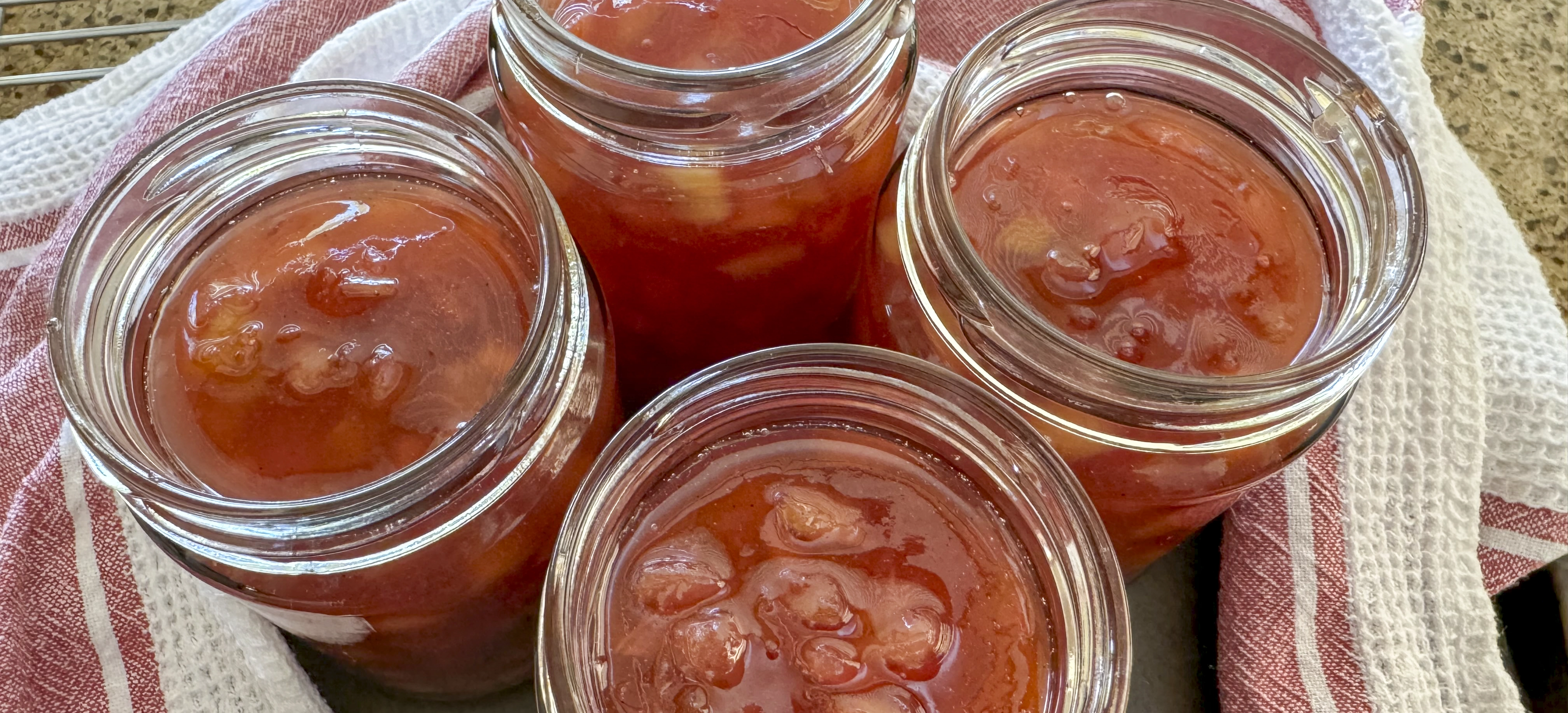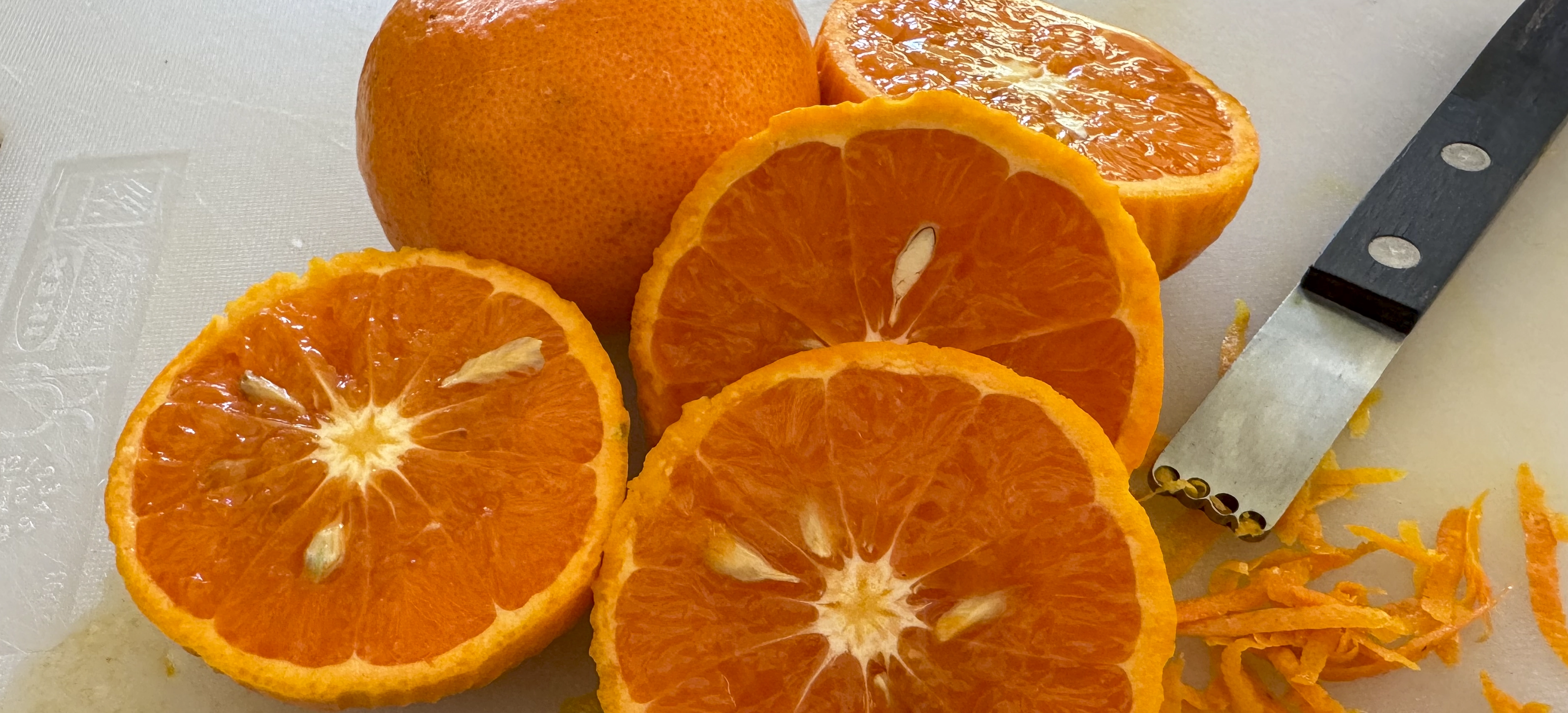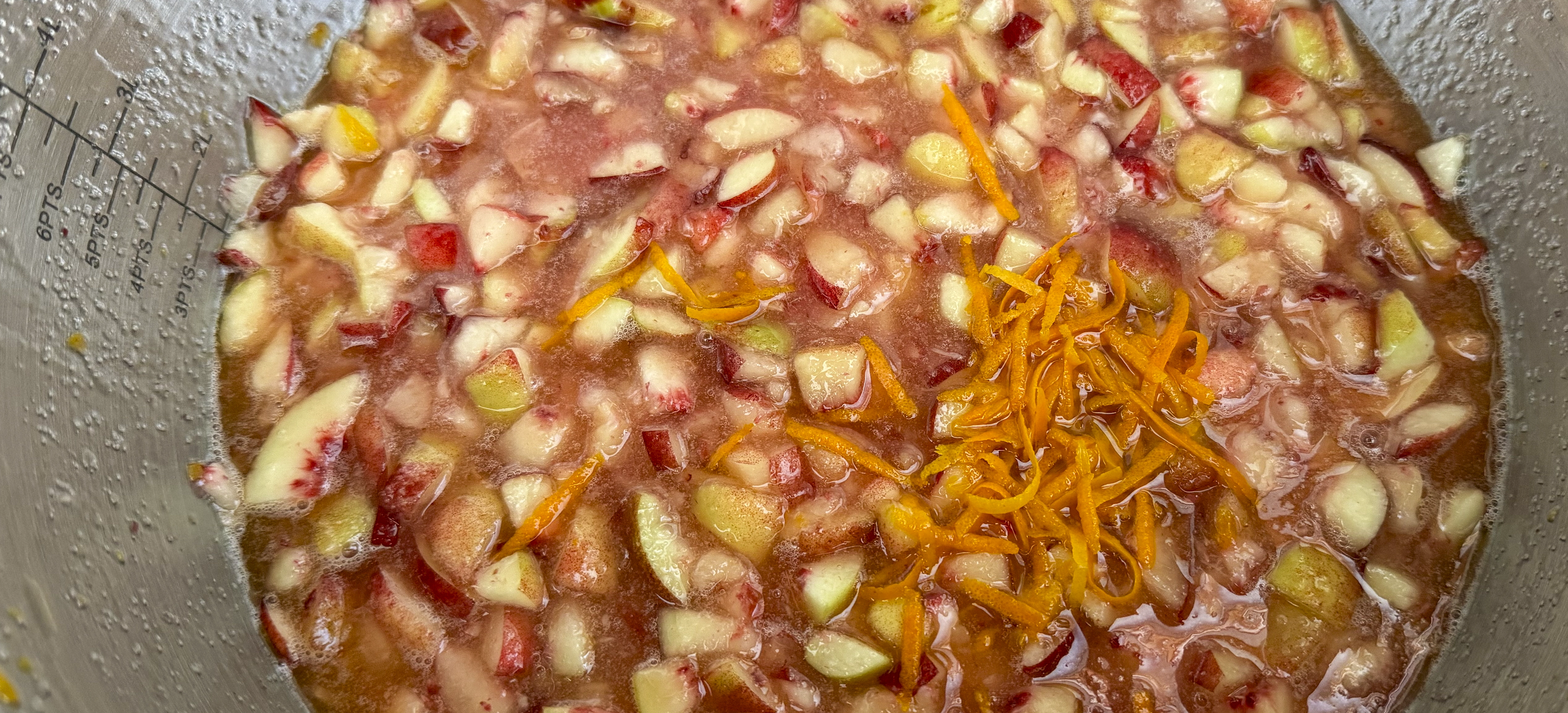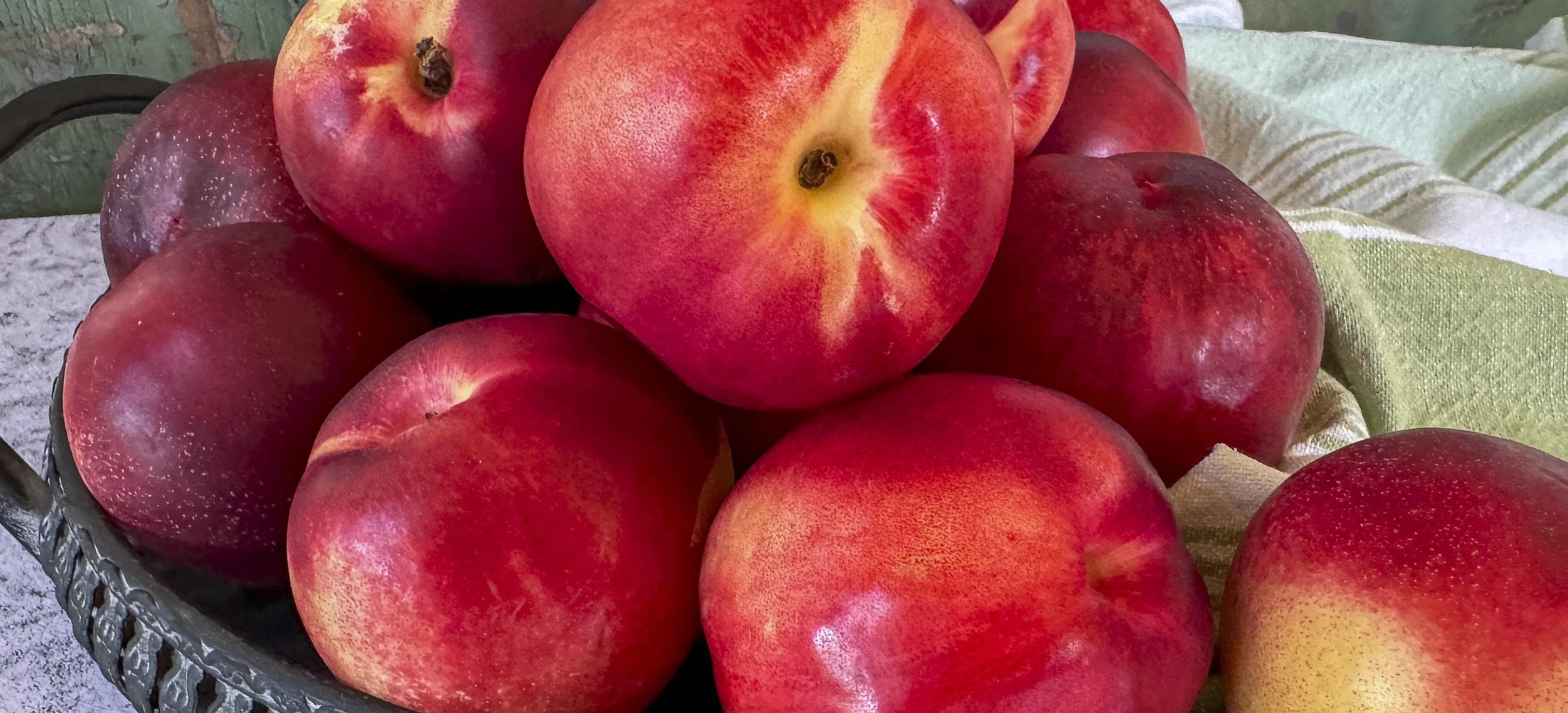Nectarine & Mandy Jam
- Jams, Jellies & Marmalades

Combining luscious ripe nectarines with mandarin and a touch of vanilla creates an elegant summertime preserve. Nectarines are often eaten before there’s a chance to conjure up a preservers pot, but if you can put aside a few, there’s a delicious reward waiting for you. Select deep red coloured fruit as it produces a gorgeous orangey/red preserve that looks stunning! Use liberally on your favourite breakfast bread from a buttery croissant to a tangy sourdough, or to flavour up granola, chia pudding or muesli for an inspired brekky fibre bowl or simply over a favourite cake, pudding, yoghurt or ice cream. Celebrate the stone fruit season with a pot of Nectarine and Mandy Jam throughout the rest of the year.
- Preparation Time:
- 40 minutes
- Cooking Time:
- 45 minutes
- Quantity:
- 5 x 350 ml jars
INGREDIENTS
- 1 kg
- Nectarines, de-stones
- 3
- Mandarins, juice & zest
- 600g
- White sugar
- 1/2 teaspoon
- Vanilla bean paste

METHOD
To core the nectarines, use a small sharp knife and insert until you feel the stone. Then carefully cut around the middle of the fruit along the natural crease that runs from the stem to the tip. Using your hands, twist each of the halves in the opposite direction to separate the fruit from the stone.
To remove the stone, use a spoon to run around it and then dig up under the stone to release it. If this is too difficult carefully lever it out with a table knife. The best method is a personal thing and will depend upon the ripeness of the fruit.
Coarsely chop the nectarines, (leaving the skin on) and place in a stainless-steel preserving pot or a heavy bottomed stainless-steel pot.
Wash the mandarins to remove any dirt or unwanted residues and garden debris.
Using a grater or citrus-peel shredder, remove the zest. Cut in half and juice, remove the pips and add the rind and juice to the pan.
Add the warmed sugar and stir well so the fruit, juice, zest and sugar combine to create a syrupy mixture.

Place on the heat and bring to a simmer, stirring constantly until all the sugar has dissolved.
Bring to the boil and boil rapidly until the setting point is reached.
In the meantime, sterilise the jars and lids and have them hot and dry, ready for the bottling stage.
Using a sharp-edged spoon or ladle, remove the scum that accumulates around the edge of the pot as it builds up.
When the jam has reached the setting point, remove it from the heat and place on a heat-resistant board and allow to sit for 5 minutes. If bottled immediately it’s likely the fruit pieces will rise from the bottom of the jar.
Using a wide-necked funnel, ladle into warm sterilised jars to within 2.5 cm (1 inch) from the top, distributing the fruit evenly between the jars. Seal immediately with hot dry lids. The HHH method of HOT dry jars, HOT dry lids and HOT jam creates a vacuum seal as it cools. The “popping” sound, often heard in the kitchen, signals a successfully vacuum sealed jar.
If there are no lids, seal with paraffin wax while the jam is hot. Cover with cellulose or plastic film and secure with a rubber band or kitchen twine. Refer to the Notes Section: Sealing with Paraffin Wax below for more detailed instructions. Alternatively allow the jam to completely cool and seal with a screw top lid.
The HHH method of sealing is preferred as there is reduced risk of contamination prior to sealing.
-
Allow the jars to cool, wipe down to remove any spillage and label. Store in a cool dark place in the kitchen or pantry.
Allow the jam to mature for at least 2 weeks before eating.
NOTES
- Choose ripe but not over ripe or mushy fruit and never use mouldy produce as this produces a poor-quality jam.
- This will be a soft set jam as nectarines low in acid and pectin and require the addition of citric acid to help make them set. Lemon and lime juice are amongst the richest sources in the citrus family, however the mandarin is a delicious addition and adds a natural sweetness and aromatic flavour. If for some reason, the jam has difficulty in setting, add the juice of a lemon. If it doesn’t set don’t discard use as a delicious sauce to accompany cake, dessert or spooned lovingly over ice-cream.
- Nectarines have either a yellow or white flesh and a deep pink or pale skin. The cling stone varieties have the fruit woven into the flesh while the stone is easily separated from the flesh in the free stone varieties.
- I prefer to use the cling stone varieties for preserves as it stands up to the rigors of boiling rapidly (for jam) or long slow simmering (for chutney) better than the more delicate free stone varieties. These are best eaten fresh.
- Kitchen twine, also known as butcher’s or cooking twine, is made for either a 100% cotton, linen or a cotton/polyester blend. The best and safest is the 100% natural cotton as it withstands long cooking, does not impact flavour into cooked food and is food safe. Do not use synthetic twine made from either polypropylene or polyester or a blend of these with a natural twine as they aren’t oven safe. If you purchase a natural kitchen twine it will be safe for all your cooking needs. It is sold in kitchen equipment or stores that sells twines.
- If you do not have a preserving pan, use a large heavy bottom pot, preferably stainless steel
- This will distribute the heat evenly across the pot and the jam while it is cooking. Ensure there is enough space available in the pot for the mixture to double in size while it is rapidly boiling.
- To warm the sugar put the recipe quantity in an oven proof container and place in a preheated 150 degrees C oven for approximately 10 minutes. The sugar should be warm throughout the bowl. Ensure the sugar has completely dissolved before boiling, otherwise the sugar may crystallise later in the jar. Warmed sugar dissolves quickly and then a rapid boil until the setting point is reached, helps to preserve the fresh fruit flavour. Long slow simmering of jam affects the colour and reduces its flavour.
- Good quality jars should be used in all preserving, particularly when they are processed in a hot water bath. Thin jars often cannot withstand the temperatures and may crack either in the bath or on and or after removal. Avoid the disappointment and invest in some good jars from a homewares or preserves outlet.
- Cooking times are an approximation only. They are provided as a guideline as cooking times are influenced by the type of pot and its diameter and height, speed of cooking and fruit ripeness, size, and moisture level.
- Removing the scum
- Jam, jellies, and marmalades can produce a scum while they are boiling. Impurities from the fruit and sugar will rise to the surface and a fine frothy foam will move towards the edge of the preserving pan. Some fruits will produce more scum than others.
- This is a natural self-clarification process and makes the task of making a high-quality preserve easier. Removing the scum increases the preserve’s clarity. This is very important if it is being submitted for competition. Remove the scum before bottling. Using a stainless-steel spoon, skim the scum from around the edge of the preserving pan. Be careful to remove just the scum and not the jam. This can be done while the jam is boiling and/or once it has been taken off the heat. Do not attempt to remove the scum from the centre of the boiling jam, as there is an elevated risk the jam will splutter and hot jam burns.
- Sealing paraffin Wax
- Paraffin wax is available in speciality preserving stores and some rural hardware stores.
- The melted wax must be poured over the preserve while both are hot.
- Break the wax into small pieces and heat in a bowl set over a pan of hot water. Bring the water to the boil, reduce the heat to maintain a gentle simmer until the wax is just melted.
- Do not overheat. If it gets too hot it will shrink away from the sides of the preserving jar as it cools. This will break the seal and allow impurities to access the contents, encouraging mould growth.
- Working quickly, pour a thin layer over the hot preserve. Using a small wooden cocktail stick, toothpick, or cake skewer, prick any air bubbles.
- Allow the wax to set. Then pour a second thin layer to make a seal approximately 3mm thick.
- When the wax has set it will become opaque and dip slightly in the middle.
- Cover the jar with a cellophane disc and secure with a rubber band/kitchen twine.
- To use the preserve, break the wax seal and remove. Discard or wash thoroughly, dry and re-use later as required.
- Sealing with wax is not a longer-term storage solution. Use within a couple of months. Once opened store in the fridge.
- Did You Know?
- A common misconception is the nectarine is a cross between plum and peach. But they are just a fuzziless peach.
- Peaches and nectarines are genetically identical except for one gene.
- It’s a natural genetic variation and yes, it’s the one that puts a fuzzy or downy skin on the peach.

